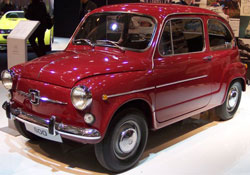
The Zastava 600 (fića) packed a 16kW engine. Production began on October 18th, 1955. The 600D; 750; 750M; 750S, and 850 would follow
In a referendum held on August 26th, 1953, 96% of the employees of then-
Zavodi Crvena Zastava voiced their desire to produce automobiles. That year, 162 Jeep Willys would leave Kragujevac lines.
Zastava signed a historic agreement with Fiat on August 12th, 1954. Three months later, Kragujevac began assembling the Fiat AP-55 (aka
Kampagnola); Fiat 1400 BJ, and Fiat 1100 B. In these parts, the Kampagnola is nearly as famous as the Willys for its ultimate ability in all types of terrain.
The 1400 marked Zastava's first automobile, but not its most famous; that would be the legendary
fića.
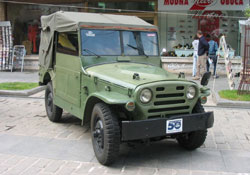
In these parts, the Kampagnola is nearly as famous as the Jeep Willys for its ultimate ability in all types of terrain
Some cars leave their mark on history for the technological or styling innovations they bring forth. Others are remembered for the role they have played in shaping the culture of an entire generation or country.
Few, however, succeed in being remembered for both technology and sentiment.
Few have left so indelible a mark as to become an icon of their age.
At 10am on October 15
th, 2005, hundreds of
fića (Zastava 600/ 750/ 850) owners gathered outside Zastava's offices in Kragujevac. They had come from across the former Yugoslavia to mark the 50
th birthday of Zastava's most celebrated line: its smallest car ever, and the car which put Yugoslavia on wheels.
This was, as author Jonathan Mantle puts it,
"one of the very few cars to have transcended its origins and become synonymous with a landscape; a people, and a way of life" (Car Wars, Jonathan Mantle, Arcade 1995). 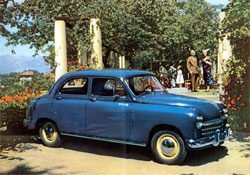
The unibody Fiat 1400 became Zastava's first automobile
The 600 was not the first Zastava. Yet the affordable, endearing 600 and its variants are no doubt Zastava's most famous cars (in its home market, at least), with 923,487 produced from October 18
th, 1955, through November 18
th, 1985. Certainly, they rank among the most characterful runabouts ever made.
The
fića started life as the 16kW 633cm
3 Fiat 600, designed by the legendary Fiat engineer Dr. Dante Giacosa.
His brief? To deliver a small, frugal vehicle that could transport four; a successor to the prewar Fiat 500, or
Topolino. Dr. Giacosa was hypnotized by the Vespa motor scooter created by the helicopter designer D'Ascanio. What Italians wanted, he was convinced, was a four-wheeled Vespa. Within just ten months, Giacosa had created the first monovolume car ever produced. A unibody chassis saved weight; a rear-mounted engine saved energy in getting power to the rear wheels.
Dante Giacosa: among the world's greatest small-car designers ...
(more) 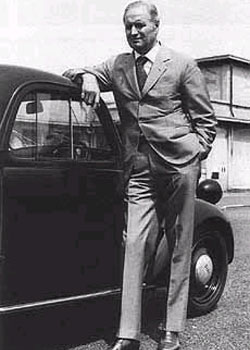
Dr. Dante Giacosa is recognized as one of the greatest small-car designers of all time. Zastava's 1400; 600/ 750/ 850; 128; 101, and Yugo owe their engineering to his talent. Giacosa's Fiats motorized Italy; as Zastavas, they put Yugoslavia on wheels
Dr. Dante Giacosa (January 3, 1905 - March 31, 1996) is today recognized as one of the greatest small-car designers of all time.
A graduate of Turin's Polytechnic university in 1927, he joined Fiat the following year.
In 1933, Giacosa was entrusted with the design of all the mechanical components of Fiat's 500, quickly dubbed
Topolino (little mouse) by Italians drawn to its toy-store looks.
Giacosa despised the gas-guzzling monsters dreamed up in Detroit. The postwar success of Fiat was rooted in Giacosa's egalitarian vision of the automotive as a safe and economical means of transport for the average Italian family.
By 1950, Dr. Giacosa had become Fiat's director of engineering, responsible for the Fiat 1400, the first car ever produced by Zastava.
The engineer's greatest work was yet to come, however. The Fiat 600 put both Italy and - as the Zastava 600 - Yugoslavia on wheels. 2,777,313 were built in Mirafiori; 923,487 at Zastava's factory in Kragujevac.
The launch of the
Nuova Cinquecento made Giacosa a national hero, with three-and-a-half million made between 1957 and 1975.
By 1963, one in seventeen Italians owned a car, compared with one in ninety a dozen years earlier. 63% of them owned a Fiat.
Dante Giacosa retired as chief engineer and designer in 1970. Until his death in 1996 at the age of ninety-one, he lived and worked as a consultant for Fiat in Turin.
An intuitive designer who was a great admirer of the art of Goya and Picasso, Dr. Giacosa never made his peace with computers and wind tunnels. "The electronic calculator compresses creativity," he once said.
"It can only rapidly verify results, not anticipate them."
Dr. Giacosa's favorite design principles -
clarity of line, simplicity of use - continue to define the most successful Fiats today.
In most variants barely capable of 60 mph, the robust little car was nevertheless perfect for commuting, and mobilized generations like few cars in history have: think Austin's Mini in Britain, and Citroën's 2CV in France.
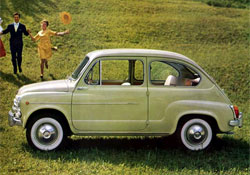
Zastava's fića put a nation on wheels. Length: 3,295 mm. Width: 1,380 mm. Height: 1,405 mm. Wheelbase: 3,295 mm. Curb weight: 585 kg. Track (f/r): 1,150mm/ 1,160mm
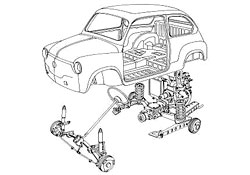
Zastava made both the 600 and the 1960 18kW 767cm
3 Fiat 600D, which as the Zastava 750 managed a top speed of 110 km/h.
Hydraulic drum brakes sat at all four wheels. Front suspension was by a unique single double-mounted leaf spring, acting as a stabilizer, placed between the front wheels and coupled to gas-charged shock absorbers. At the rear, an independent coil-over shock absorber setup was coupled to semi-trailing arms.
All 600/ 600D/ 750 models had 3-synchro (no synchro on 1
st), 4-speed transaxles.
As Italian production of the vehicle ended, it fell to Zastava to move the design forward. In 1970, Zastava rolled out the 750M, fitted with a new 795cm
3 engine boasting a thermostat-controlled closed cooling system.
For 1979 came the 750S
(Special), which boasted Fiat 126-inspired fascia upgrades (including a tachometer); a new steering-wheel, and a 22kW engine which brought the top speed to 120 km/h.
In 1980, the 850 was launched, with a 23.4kW 848cm
3 engine propelling it to 125 km/h. A fully-synchronized transaxle and front disc brakes were introduced.
Both 750 and 850 continued through 1985 in
L; LE, and
SC versions.
Finally, the design was sold to the Tofas factory in Turkey, which continued to produce these cars, under Zastava license, into the '90s.
On April 4
th, 2000, Novi Sad's
Privatni pregled newspaper elected the
fića the ex-Yugoslavia's Car of the Millennium. Certainly, the
fića's endearing ability to take a beating and come back for more kept it in production with only minor changes for more than thirty years.
In 1955,
Crvena Zastava made 1,044 vehicles; in 1958, 3,596. 1957 and 1958 are generally viewed as the years in which Zastava's supplier network was established. By this time, Zastava was turning out its own chassis and parts, while the Rakovica-based supplier
2. maj was producing engines.